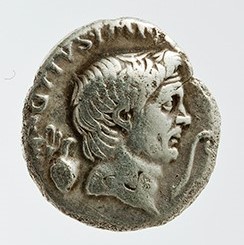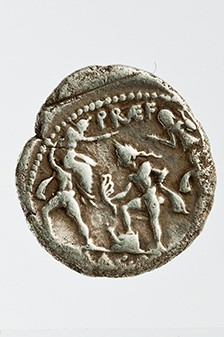Acquisition number: 1972.02
Obv.: Head of Cn. Pompeius Magnus r.; behind, a capis (ritual cup); in front, a lituus (augur's staff). MAG(nus) PIVS IMP(erator) [ITER(um) — clipped off]. Trace of border of dots.
Rev.: Neptune standing l., between the brothers Anapias and Amphinomos, who carry their parents on their shoulders. Neptune has aplustre (a ship’s stern-post) in right hand and cloak over left arm; he rests right foot on prow. Above, PRÆF(ectus); in exergue, [CLAS(sis) ET ORAE MARIT (imae) EX S.C.] — worn off. Border of dots.
Title: Denarius of Sextus Pompeius - 1972.02
Acquisition number: 1972.02
Author or editor: Beryl Rawson
Culture or period: Roman Republic
Date: 42-40 BC
Material: Metal - Silver
Object type: Coins - Roman
Dimensions: 17mm (w)
Origin region or location: Italy
Origin city: Catana
Display case or on loan: 5
Keywords: Coin, denarius, Roman, Republic, Pompey, Neptune, Sextus Pompeius
Sear, D.R., Roman Coins and their Values 5 vols (London, Spink, 2000-2014) 1392; Crawford, M., Roman Republican Coinage 2 vols (Cambridge, Cambridge University Press, 2011) 511/3a and pl. LXII.2; Sear, D.R., The History and Coinage of the Roman Imperators (London, Spink, 1998) 334; Seaby, H.A., Roman Silver Coins (London, B.A. Seaby, 1967) Pompey the Great 17 (Sicily 42-40 BC); Sydenham, E. A. The Coinage of the Roman Republic (London, Spink, 1952; (Sanford J. Durst repr. 1976) 1344.
Cf. Poole, R.S., (ed.), A Catalogue of the Greek Coins in the British Museum (London, The British Museum, 1873-1927; repr. Bologna 1963-1964) Sicily 52-53 n.70-79.
1972.02
Denarius of Sextus Pompeius
3.425 g. 42-40 BC
Obv.: Head of Cn. Pompeius Magnus r.; behind, a capis (ritual cup); in front, a lituus (augur's staff). MAG(nus) PIVS IMP(erator) [ITER(um) — clipped off]. Trace of border of dots.
Rev.: Neptune standing l., between the brothers Anapias and Amphinomos, who carry their parents on their shoulders. Neptune has aplustre (a ship’s stern-post) in right hand and cloak over left arm; he rests right foot on prow. Above, PRÆF(ectus); in exergue, [CLAS(sis) ET ORAE MARIT (imae) EX S.C.] — worn off. Border of dots.
capis: one-handled pitcher, used during sacrifices. (See Livy 10.7.10.)
lituus: curved staff carried by augurs. (Livy, 1.18.7.)
aplustre: ornamented stern of a ship, often a symbol of naval spoils.
Minted by Sextus Pompeius, the younger son of Pompey the Great, in the period when Sextus held a naval command as Prefect of the Fleet and of the Sea-coast (‘praefectus classis et orae maritimae’) 43-40 BC. It may belong to 42 BC, when he celebrated his second major victory: imperator iterum = ‘victorious commander for the second time,’ (The first victory was in Spain in 44 BC; this second in Sicily.) He was officially named augur-elect in 39 BC, but he had claimed the augurate for some years and the augur’s symbols here may predate 39 BC. The place of minting was almost certainly in Sicily (Sextus’ headquarters), and the reverse type of the brothers of Catana suggests Catana as the specific town.
The coin advertises Sextus’ devotion to his father’s cause (the augur’s symbols on the obverse, repeated from Pompey the Great’s coins; Sextus’ names; the dutiful sons of Catana on the reverse), and Sextus’ own naval power.
Anapias and Amphinomos were a pair of brothers of Catana in Sicily, famous for pietas (dutiful respect). Their story usually took some such form as this: during an eruption of Mt. Etna they carried their parents out of danger on their shoulders, ignoring the advancing stream of lava which, at the last moment, miraculously parted to leave them unscathed. Statues of the young men were set up at Catana, and their deed was commemorated on local coins (see BMC: 3rd cent. BC). The story is first known from the 4th century BC: Lycergus (In Leocratem 95) refers to the cult, but mentions only one son, without naming him. The story became widespread, and the men are often called simply ‘the Sicilian brothers’ (Seneca De Beneficiis 3.37.2, 6.36.1; Silius Italicus 14.197; Martial 7.24.5; Pausanias 10.28.3). The parallel with the legend of Aeneas and Anchises is obvious, and Sextus Pompeius’ use of this story may suggest an attempt by him to compete in pietas (dutiful respect) with Octavian (the dutiful son — adoptive — of Julius Caesar). An earlier Roman with Sicilian connections, Marcus Herennius, used the same story on his coinage (c. 108 BC) and made its point explicit with the legend PIETAS (Sear 185; Crawford 308; Sydenham 77).
Sextus Pompeius carried on resistance to Julius Caesar in Africa and in Spain after the deaths of his father and elder brother. Pietas was the battle-cry of the Pompeians at Munda, in Spain, in 46 BC. (Appian Civil Wars 2.104: Caesar used Venus), and it was probably about this time that Sextus took on not only his father’s name of Magnus but the further name of Pius.
After Caesar’s death in 44 BC, the senate made overtures to Sextus to help in the fight against Antony. Cicero (Philippics 13.12) offered to nominate Sextus to the position of augur left vacant by the death of Pompey the Great. In 43 BC Sextus was given an official naval command, with the title ‘praefectus classis et orae maritimae’. (Cf. his father’s naval command, 67 BC. Note also the ‘Pompeian’, or anti-Caesar, mood of the senate: it was also in 43 BC that Brutus and Cassius had their important eastern commands legitimized.) But after the formation of the Second Triumvirate later in 43 BC, Sextus did not dare return to Rome and began freelance naval operations based on Sicily. His force included slaves, ex-slaves, and anti-Caesar refugees, and these blockades threatened Rome with starvation. The triumvirs, unable to defeat Sextus in battle and divided amongst themselves, made a settlement with him in 39 BC; he was recognized as governor (proconsul) of Sicily, Sardinia and Corsica and he was to become an augur. Sextus used the title of augur, although he never went to Rome to be officially inaugurated. Hostilities broke out again in 38 BC, and continued until the forces of the triumvirs (led by Agrippa) finally defeated Sextus in a naval battle (Naulochus) in 36 BC. Sextus fled to the East, where he was killed by one of Antony’s officers.
In his naval operations Sextus not only called on memories of his father but also associated himself with the sea-god Neptune. ‘He represented himself as the son of Neptune, since his father had once ruled the whole sea.’ (Cassius Dio 48.19.2) He exchanged the purple cloak of a Roman commander for a dark blue one ‘to signify that he was the adopted son of Neptune,’ and before the battle of Naulochus he offered sacrifice to the sea and to Neptune (Appian Civil Wars 5.100). When Sextus was blockading Rome’s food supplies in 40 BC and the Roman people were putting pressure on the triumvirs to make a settlement with Sextus, the association with Neptune was important for Sextus’ reputation: ‘(The people in Rome) at the games in the Circus honoured by loud applause the statue of Neptune carried in the procession, thus expressing their great delight in him (Sextus). And when on certain days it was not brought out, they took stones and drove the magistrates from the forum, threw down the statues of Caesar (= Octavian) and Antony…’ (Cassius Dio 48.31.5). Horace later referred to Sextus as Neptunius dux (Neptune’s general) (Epodes 9.7).
Because of Sextus’ freelance activities and his use of slaves and ex-slaves, he was sometimes represented by his enemies as a pirate. Augustus’ claim, ‘I freed the sea from pirates’ (Res Gestae 25) refers to his victory over Sextus; cf. Horace’s line contra latrines atque seruilem manum (against pirates and the hand of a slave) (Epodes 4.19).
Representations of Pompey the Great on coins are all posthumous: he never put his head on his own (rare) coins.
Sear, D.R., Roman Coins and their Values 5 vols (London, Spink, 2000-2014) 1392; Crawford, M., Roman Republican Coinage 2 vols (Cambridge, Cambridge University Press, 2011) 511/3a and pl. LXII.2; Sear, D.R., The History and Coinage of the Roman Imperators (London, Spink, 1998) 334; Seaby, H.A., Roman Silver Coins (London, B.A. Seaby, 1967) Pompey the Great 17 (Sicily 42-40 BC); Sydenham, E. A. The Coinage of the Roman Republic (London, Spink, 1952; (Sanford J. Durst repr. 1976) 1344.
Cf. Poole, R.S., (ed.), A Catalogue of the Greek Coins in the British Museum (London, The British Museum, 1873-1927; repr. Bologna 1963-1964) Sicily 52-53 n.70-79.

